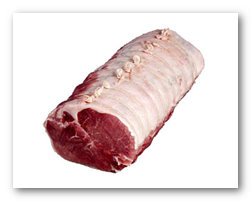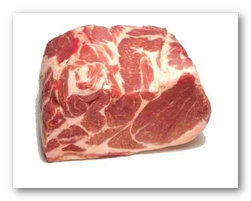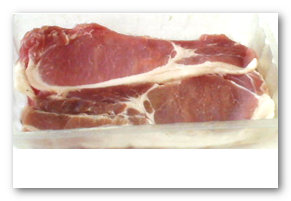








Pork and Bacon
Pork is the gastronomical name for meat from the domestic pig. The word pork denotes specifically the fresh meat of the pig that is left unsalted, but it is often mistakenly used as an all-inclusive term which includes cured, smoked, or processed meats (ham, bacon, prosciutto, etc). Pork is very high in thiamin (vitamin B1).
Spare Rib Roast/Spare Rib Joint/Blade Shoulder/Shoulder Butt
This is the shoulder and contains the shoulder blade. It can be boned out and rolled up as a roasting joint, or cured as "collar bacon". Not to be confused with the rack of spare ribs from the front belly. Pork butt, despite its name, is from the upper part of the shoulder. Boston Butt, or Boston-Style Shoulder, cut comes from this area, and may contain the shoulder blade.
Hand/Arm Shoulder/Arm Picnic
This can be cured on the bone to make a ham-like product, or used in sausages.
Loin
This can be cured to give back bacon or Canadian-style bacon. The loin and belly can be cured together to give a side of bacon. The loin can also be divided up into roasts (blade loin roasts, centre loin roasts, and sirloin roasts come from the front, centre, or rear of the loin), back ribs (also called baby back ribs, or riblets), pork cutlets, and pork chops. A pork loin crown roast is arranged into a circle, either boneless or with rib bones protruding upward as points in a crown. Pork tenderloin, removed from the loin, should be practically free of fat.
Fatback
The subcutaneous fat and skin on the back are used to make pork rinds, a variety of cured "meats", lardons, and lard.
Belly/Side/Side Pork
The belly, although a fattier meat, can be used for steaks or diced stir-fry meat. Belly pork may be rolled for roasting or cut for streaky bacon.
Legs/Hams
Although any cut of pork can be cured, technically speaking only the back leg is entitled to be called a ham. Legs and shoulders, when used fresh, are usually cut bone-in for roasting, or leg steaks can be cut from the bone. Three common cuts of the leg include the rump (upper portion), centre, and shank (lower portion).
Ham is a cut of meat from the thigh of the hind leg of pigs. Nearly all hams sold today are fully cooked or cured. Gammon steaks are thick cut and circular in shape. The word Gammon derives from the Old Northern French word jambe for hind-leg of the pig. The depth of meat to the bone is greatest at the top of the hind limb; cutting this piece from the side and curing it separately therefore cures the meat thoroughly, easily, and this cut is the original and to this extent authentic form of Gammon.
Trotters
Both the front and hind trotters can be cooked and eaten, as can the tail.
Spare Ribs
Spare ribs, or spareribs, are taken from the pig's ribs and the meat surrounding the bones. St. Louis-style spareribs have the sternum, cartilage, and skirt meat removed.